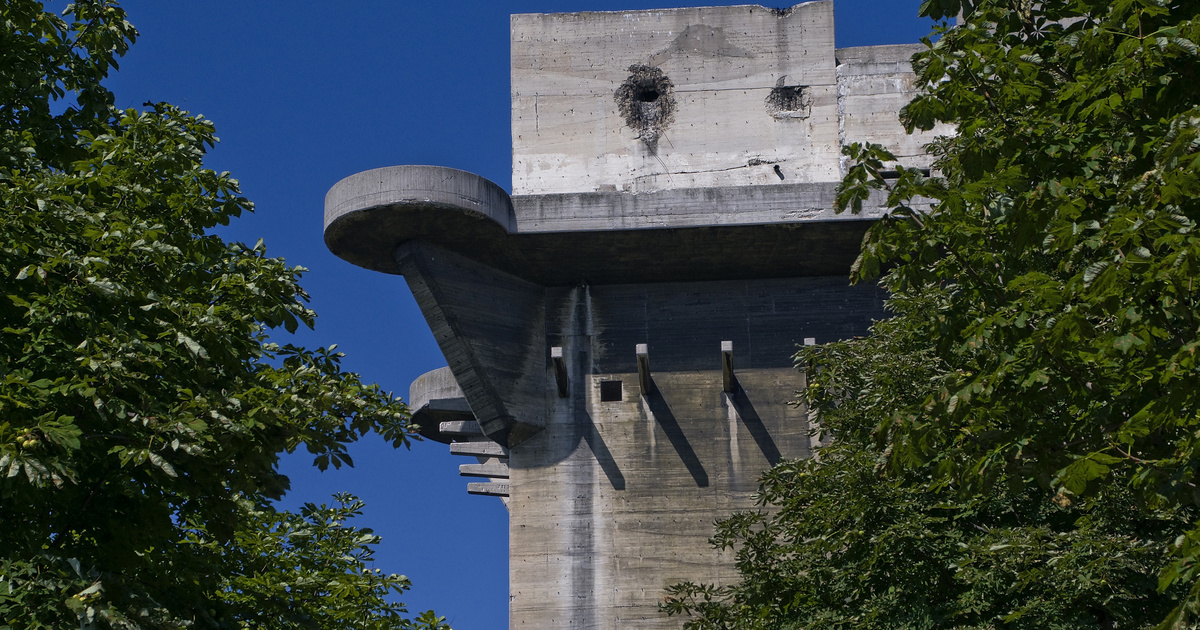XX. century medieval
Due to the increasing frequency and 29 effective attacks of the Anglo-Saxon Air Force, the Germans developed three types of air defense fortress towers in the II. during World War II to protect their big cities. The first-generation four pairs of air defense towers, designed by Friedrich Tamms, were inaugurated between April 1941 and October 1942. When designing the artefacts, the engineer had to take into account that due to the dense urban construction, his future structures, the so-called Flakturm (Flugabwehrkanone-turm), had to rise above the surrounding buildings, thus determining the height of all eight “Nazi knight castles” at 39 meters.
The four pairs of towers were built in the Berlin Zoo, the Friedrichshain and Humboldthain National Parks, and in the middle of the port city’s public park called Holy Spirit Field to protect Hamburg’s shipyards.
The capital’s fourth pair of air defense forts was not built by the Germans on the edge of Hasenheide Park because it also housed the Tempelhof airport used by the Luftwaffe, whose military strength Hitler thought in 1940 was sufficient to protect the southern side of Berlin, the future German capital.
–
–
The pairs of towers were built by thousands of laborers and prisoners of war, in addition to the local workforce, under the supervision of the Organization Todt. The stoutest members of the first-generation fortress pairs were the 70.5 × 70.5-meter-wide, 3-and-a-half-meter-thick fortifications, called G-towers (Gefechtsturm – battle tower), with four 128-millimeter cannons running on top of four corner bastions. , four 30 and 2 37 mm machine guns and 8 four – barrel, 20 mm machine guns were also installed.
While artillery districts were formed on the top floor of the five-storey residential and shelter tower, the Air Force trained hospital facilities and ammunition depots on the floors below. On the two lowest levels, the Germans also set up a shelter for 10-10 thousand people. Of course, each tower was equipped with its own emergency generator, gas filtration equipment and wells completely independent of the city’s drinking water network. The second element of the tower pairs was laid out by the Nazis at least 100 meters away from the G-towers due to the mouth fire, dense smoke, precise targeting, where the fire control points were always installed.
Of course, there were weapons on the roofs of the twin buildings called the L-tower (Leitturm – control tower), but their firepower was much more modest compared to the G-towers. Only 8 four-barreled, 20-millimeter machine guns were installed here by the Germans, as most of the roof, which was also 5 meters thick, was occupied by a FuMg 65 Würzburg-Riese radar. Although the control towers were also built 39 meters high, their side walls were “only” 50 × 23 meters.
Regardless of the location, the G and L towers were always connected by a one and a half meter thick cable tunnel in which people could also travel. For easy fire control, the twin towers were always placed at the same height.
In the event of a total fire, a tower could fire 8,000 shots per minute, which was a very significant firepower at the time.
–
–
In the case of a horizontal shot, the cannons could fire up to a distance of 20.9 km, and in the case of a “bent shot” up to a height of 14.8 km.
By the end of the war, the crew of the towers were already largely members of the Hitlerjugend. During the Soviet siege of Berlin, the civil and military significance of “knight’s castles” was further enhanced:
Instead of the original 10-10 thousand people, the G-towers were already crowded with 30-30 thousand people, with the Germans guarding the upper floors of Flakturm I at the Berlin Zoo. PRIAMOSZ KIRÁLY Known from the Schliemann estate, 8900 gold treasures and the Pergamon altar.
–
–
Of course, the dreaded treasures of the museums of the capital can be found not only here, but also in the Friedrichshain grove of Flakturm II. it was also kept at the upper level. Here, for example, a collection of almost 1,660 pieces from the City Gallery and the National Gallery was transported, including a number of Caravaggio, Canaletto, Tiziano, Botticelli, Dürer, Bruegel, Bosch, Goya, Murillo, Velázquez, Poussin, He covered Rembrandt, Rubens paintings and etchings. These world-famous paintings were taken with the treasure of war by the Soviet Red Army together with the treasure of Priam of Trojan, some of which were exhibited at the Pushkin Museum in Moscow and the Hermitage in Leningrad / St. Petersburg.
–
The densely ironed forts of Berlin could not be dismantled by the Soviets with their 203-millimeter tars. The last centers of resistance were also formed in these buildings.
–
–
The two zoo air defense towers could only be exploded in July 1948 by the British with great difficulty, for the third run (using 12, 25, and then 40 tons of TNT). The ruins were buried. (Flakturm IV in Hamburg has continued to function as a media center and orchestra for rehearsals since 1990.)
As the G and L towers lived up to their promise, the German military command in October 1943 ordered the design of a second-generation tower pair type. Here the dimensions have been changed somewhat. The G-towers grew to a height of 42 meters and their sides were 57 meters long. The wall thickness was reduced to 2 meters and the roof to 3 and a half meters. The armament was also less than that of the first-generation towers, as only 4 double-barreled, 128-millimeter cannons and 8 four-barreled, 20-millimeter machine guns were installed here. What has become more is the number of floors, where the “residential towers” have already been divided into 10 levels. The L-towers in the second series were 44 meters high and 50 × 23 meters long. On top of these were also a Würzburg-Riese radar and a 10-barrel, 20-millimeter machine gun.
Two pairs of second-generation towers were built in the Third Reich. While the Flakturm VI fort was again given to the city of Hamburg (Wilhelmsburg), the towers named Flakturm VIII were given to Vienna (Arenbergpark).
Of the Hamburg towers, the L-tower was blown up, but only the internal structure of the G-tower was damaged by the English. Today, this concrete castle, called “Energiabunker”, functions as one of the city’s solar and mobile player antenna sites, as well as a lookout. The Austrian G-Tower houses the warehouse of the Vienna Museum of Applied Arts, the CAT-Contemporary Art Tower, and the L-Tower houses a computer center and several fine art galleries.
–
–
The third generation of air defense towers differs significantly from the former at first glance. Here, the G-towers already had a circular floor plan with a diameter of 43 meters and a height of 54 meters. Their weapons were 4 two-barreled, 128-millimeter cannons and 8 four-barreled, 20-millimeter machine guns. The L-towers that belonged to it were actually second-generation towers. A total of two pairs were built. Flakturm V. was built in the Esterházy Park in Vienna, while Flakturm VII. also named the silhouette of the imperial city in Augarten. The latter became unusable due to an internal ammunition explosion. It is also used as a climbing wall
The Vienna Museum of Torture operates in the Esterházy Tower, and the work in Augarten continues to function as an IT data center.
–
–
– .


